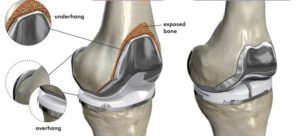Knee Joint Replacement Surgery
The knee joint is a very important part of the body that needs to be adequately taken care of. The knee joint supports the whole body weight during walking. Especially when one of your legs is in the air during walking, the knee joint of the other leg supports and transmits the whole weight of the body to the ground. Since the knee joint is overworked all the time, it is prone to early damage too.
Damage to knee joint
Arthritis of the knee is the most common cause of knee damage. In this condition, the knee joint becomes inflamed and the surface is eroded. This results in severe pain over the joint surface when the patient tries to walk, even for short distance. Due to the severe pain, your movement will be limited. You will also start depending on other people for you daily needs.
Problems of a person who has knee pain
1. Severe pain while walking or even moving knee
2. Pain increases on any movement of knee
3. Joint stiffness.
4. Limited movement of knee
5. Limited knee movement leads to reduced independence
6. Increased dependence on other people for daily activities.
Solution for knee damage
The only possible solution for a knee damaged due to arthritis is knee replacement surgery. If a person with damaged knee is without any symptoms like pain or limited movements, then surgery is not needed. If there is severe pain and limited movement in the knee, knee replacement surgery is absolutely indicated. It is better to undergo knee replacement surgery and be active than start becoming inactive because of knee pain.
What is knee replacement surgery?
Getting prepared for knee joint replacement surgery
Are you getting prepared for knee joint replacement surgery? There are some important factors that you should keep in mind before you undergo knee joint replacement surgery.
1. Assessment of health by doctor: You should be ready for a full assessment of your health by your doctor. Any surgery will have some risks and your body should be ready to take these risks. This is mainly the reason why a full health assessment is necessary.
2. Physical examination: The actual area of damage in the knee has to be checked. The various deformities that already exist in your knee and other parts have to be assessed. This will also help in fine tuning to surgical technique to get best results.
3. Blood tests & X rays: Diagnostic procedures like blood tests and X rays are also important for the doctor to assess your present health condition. It will also help in getting you prepared for the knee joint replacement surgery.
4. Discussion with your doctor: Based on your health condition, the doctor will provide you certain pre operative advice. Post operative advice will also be provided to you at this stage to make you understand how you would feel after the surgery. The doctor will also talk to you about the type of anesthesia that will be provided to you. Surgery would be performed under either general anesthesia or spinal anesthesia. The risks of anesthesia is also explained to you.
The knee joint replacement surgery procedure
The knee joint replacement surgery typically lasts for nearly about two hours. An incision or cut will be made above the knee joint initially. The damaged areas of the knee are removed and then replaced with a replacement knee joint that is made from a special type of cement or other materials. This joint is also held in place by screws and pins. The incision is resutured and bandaged. Once you recover from your anesthesia, you will be sent to the ward to recuperate.
Complications after knee joint replacement surgery
Most of the knee joint replacement surgeries are 100% successful without any major complications. About 5 in every 100 patients can have minimal complications. Some of the complications that can occur after the knee joint replacement surgery are listed here.
1. Infection: Infection is the most common problem that can occur.
2. Deep Vein Thrombosis: DVT is a complication of prolonged bed rest. Adequate physiotherapy prevents this problem. You can move your ankle up and down to prevent this complication.
3. Damage to tissues: In very rare cases, there could be some damage to the tissues like nerves and ligaments during surgery.
4. PainThough pain is one of the symptoms for which surgery is being done, post operatively there could be pain. This is because of the surgery itself. This pain usually disappears over a few days. In few cases, it may persist for longer periods of time. This can be relieved with effective physiotherapy.

After the knee joint replacement surgery
The rehabilitation after the knee joint replacement surgery is quite long. Did you think that once the surgery is over, you will be discharged and you can go home? You will have to stay in the hospital for a few days so that you can get completely rehabilitated. This will also help you get back to your normal functions after being discharged.
Results after the knee joint replacement surgery
1. Reduction in pain.
2. You will be able to move your knee joint fully.
3. Your functional ability will improve.
4. You will be able to walk longer distances
5. You will be able to climb stairs.
Long term Care and precautions after knee joint replacement surgery
1. Do not put on weight: If you put on weight after the knee joint replacement surgery, then the stress on the knee joint will increase drastically causing damage to the knee joint again.
2. Crepitus: Do you feel any movement or hear sound in the knee joint? If so, then it is time for you to consult your doctor again for routine tests. Movement in joint area could mean loose bones It could also mean much worse, like damage to the knee joint surface.
Will the replaced knee last forever?
The knee that is replaced may not last forever, but it is sure to last for a long time, probably a life time for most people. Since the knee has to be replaced for people only when they are old, it needs to last for about 15 to 20 years. Also, as a person ages, the stress [p;aced on the replaced knee might be lesser. So, the knee that is replaced will usually lat till the person lives.
In most patients, the replaced knee will last for a minimum of about 20 years, but with adequate care of the knee, it can last for more years..
Physiotherapy after knee joint replacement surgery
3. Physiotherapy: Physiotherapy or Physical therapy is the main treatment in the long term after knee joint replacement. Physiotherapy helps in pain relief, improvement in muscle function, improvement in joint range of motion and also other aspects. Rehabilitation of an individual can be said to be incomplete without adequate physical therapy. Regular as well as adequate physical therapy will help an individual to become independent after knee joint replacement surgery.
Is there any alternative to knee replacement surgery?
In spite of the advances made in knee replacement surgery, there will always be skeptics who will question the need for such surgery. There will also be those who are scared to undergo the surgery. Another group of people may not have the strength to undergo such surgeries. So, they will be wondering if there is any alternative to knee replacement surgery
Innovations and breakthroughs
Innovation is the need of the hour. We are lucky to live in a generation where there is a great focus on innovation and breakthrough treatments. Many startup companies are trying out newer methods of treating existing diseases. One of the companies has developed a method in which you will be able to regenerate the cartilage as well as bones in your body. This will help in preventing the need for knee surgery. This treatment and product is called as Agili-C and it has been developed in Israel.
Agili-C has also obtained the needed approvals and has been implanted in at least 200 people.
There are also other kinds of research going on to use any alternative to knee replacement surgery. Preventive therapy with improvement in lifestyle using proper nutrition, exercises are also very useful for those who are unable to undergo this surgery.


